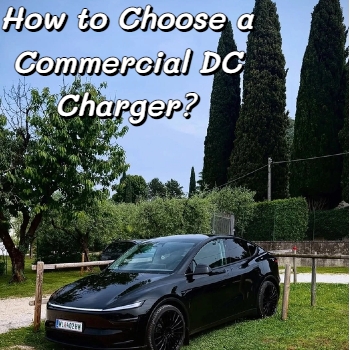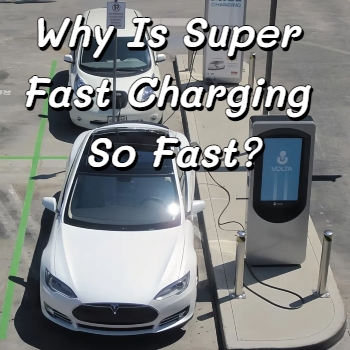Aug 14, 2025
في مناطق خدمة الطرق السريعة الألمانية، يستطيع شاحن تيسلا V4 الفائق شحن 300 كيلومتر في 15 دقيقة فقط. في المقابل، يستغرق شحن السيارة باستخدام شاحن عادي في وسط مدينة طوكيو ساعة كاملة. مع تجاوز مركبات الطاقة الجديدة "قلق المدى"، أصبحت سرعة الشحن أولوية قصوى للمستخدمين. يستكشف هذا المقال تقنية الشحن فائق السرعة، ويُبرز اختلافاتها الرئيسية عن الشواحن التقليدية، ويوصي بالشواحن العالمية المشهورة. 160 كيلو واط D30 تيار مستمر شاحن.👩🔬 "الرمز الأساسي" لسرعة الشحن: الفرق الجوهري بين التيار المستمر والتيار المترددلفهم كفاءة الشحن فائق السرعة، من الضروري توضيح مسار نقل الطاقة أثناء الشحن. يكمن الفرق الجوهري بين شواحن التيار المتردد التقليدية وشواحن التيار المستمر فائقة السرعة في طريقة التيار والمعالجة:💡شواحن التيار المتردد العاديةتُنتج هذه البطاريات تيارًا مترددًا (AC)، بينما لا تستطيع بطاريات السيارات الكهربائية سوى تخزين التيار المستمر (DC). لذلك، يجب تحويل التيار بواسطة الشاحن المدمج (OBC) قبل دخوله إلى البطارية. ونظرًا لضيق المساحة الداخلية للسيارة وظروف تبديد الحرارة، تتراوح قدرتها عادةً بين 6.6 كيلوواط و22 كيلوواط، مما يؤدي إلى بطء سرعة الشحن. على سبيل المثال، يستغرق شاحن تيار متردد بقدرة 22 كيلوواط من 3 إلى 4 ساعات لشحن سيارة كهربائية بالكامل ببطارية 70 كيلوواط/ساعة.⚡️شواحن تيار مستمر فائقة السرعةتُخرِج هذه البطاريات تيارًا مستمرًا (DC) مباشرةً، ما يُمكّنها من تجاوز الشاحن المدمج وشحن حزمة البطارية مباشرةً، مما يُلغي الحاجة إلى وصلة تحويل التيار، ويزيد من الطاقة. لنأخذ شاحن التيار المستمر D30 كمثال، فقوته البالغة 160 كيلوواط تُحسّن كفاءة الشحن بشكل ملحوظ. تُظهر الاختبارات في السوق الأوروبية أن السيارة الكهربائية المزودة ببطارية 80 كيلوواط/ساعة والتي تستخدم D30 تستغرق 25 دقيقة فقط لشحنها من 20% إلى 80%، أي أسرع بست مرات من شاحن التيار المتردد العادي.🧑💻"التكنولوجيا السوداء" للشحن فائق السرعة: ليست مجرد طاقة عالية، بل "شحن ذكي"تتبع تقنيات الشحن الفائق السائدة عالميًا مبدأً أساسيًا: ليس فقط توفير "طاقة عالية"، بل أيضًا "شحن مستقر وآمن". وهذا فرق تقني رئيسي آخر بين الشحن الفائق السرعة والشواحن التقليدية.تتميز شواحن التيار المتردد التقليدية بمنطق تقني بسيط، حيث تركز بشكل رئيسي على خرج تيار متردد مستقر مع الحد الأدنى من مراقبة البطارية في الوقت الفعلي. في المقابل، تعتمد الشواحن فائقة السرعة على "نظام تعاوني ذكي" - "موزع طاقة دقيق". شاحن تيار مستمر D30 ويجسد هذا الأمر، حيث يتميز بثلاث تقنيات أساسية:🔋تقنية ضبط الطاقة الديناميكية♦️يتواصل في الوقت الفعلي مع نظام إدارة البطارية (BMS) الخاص بالمركبة.♦️يضبط طاقة الخرج تلقائيًا وفقًا لدرجة حرارة البطارية الحالية ومستوى طاقتها. على سبيل المثال، يمكنه إنتاج طاقة تبلغ 160 كيلوواط بكامل طاقتها عند انخفاض مستوى شحن البطارية، ثم خفضها تدريجيًا عند وصولها إلى 80% لتجنب ارتفاع درجة حرارتها. وقد أظهرت هذه التقنية أداءً ممتازًا في الاختبارات التي أُجريت في المناطق الباردة بأمريكا الشمالية.🥶نظام التبريد السائل♦️يؤدي الشحن عالي الطاقة إلى توليد كمية كبيرة من الحرارة.♦️يعتمد جهاز D30 وحدة تبريد سائلة مخصصة للسيارات، مما يُحسّن كفاءة تبديد الحرارة بمقدار ثلاثة أضعاف مقارنةً بالتبريد الهوائي العادي. هذا يضمن شحنًا مستمرًا دون توقف حتى في بيئة الشرق الأوسط ذات درجة الحرارة المرتفعة البالغة 45 درجة مئوية، مما يجعله قابلًا للتكيف مع مختلف المناطق المناخية حول العالم.🚊تصميم متوافق مع الجهد الكهربي الواسع♦️تختلف معايير جهد بطارية المركبات الكهربائية العالمية (على سبيل المثال، منصات 400 فولت و800 فولت).♦️يدعم D30 نطاق واسع من خرج الجهد من 200 فولت إلى 1000 فولت، مما يوفر تجربة "توصيل وشحن" فعالة لكل من سلسلة Volkswagen ID الأوروبية وموديلات BYD وTesla الآسيوية.⁉️كيف تختار جهاز شحن سريع مناسب؟ ركّز على هذه النقاط الثلاثينبغي على مشغلي الشحن التجاري وأولئك الذين يجهزون الشواحن السريعة للحدائق أو الأساطيل مراعاة العوامل الرئيسية التالية:💡القوة:اختر 150 كيلو وات أو أعلى لتناسب الموديلات السائدة.💡الميزات الذكية:تأكد من وجود التحكم في درجة الحرارة والتعديل الديناميكي.💡التوافق:تأكد من أنه يعمل مع مختلف ماركات المركبات.شاحننا D30 DC يُلبي جميع هذه المعايير. الشحن فائق السرعة لا يقتصر على السرعة فحسب، بل هو تغيير جذري في مفهوم الشحن. مع تزايد استخدام طرازات الجهد العالي 800 فولت، ستكون شواحن 160 كيلوواط ضرورية في البيئات التجارية.للحصول على حل فعال وموثوق ومتوافق عالميًا، يرجى النقر فوق https://www.fescharging.com/ ل تعرف على المزيد حول شاحن D30 DC. يعمل على تسريع عملية الشحن وتبسيط العمليات.
اقرأ المزيد

